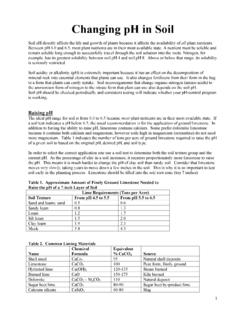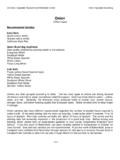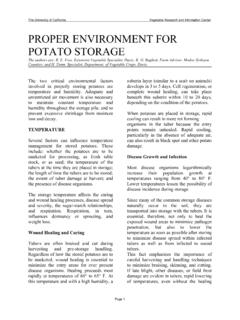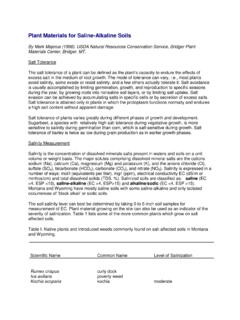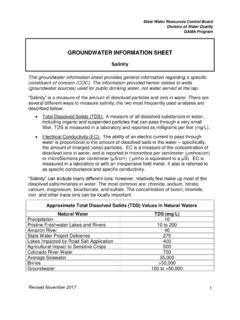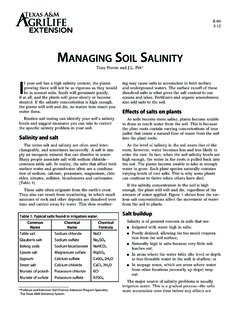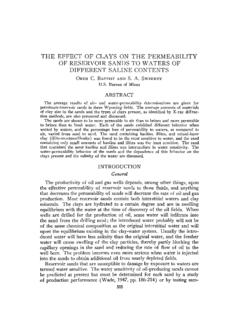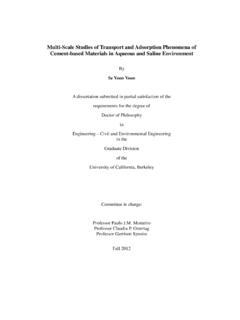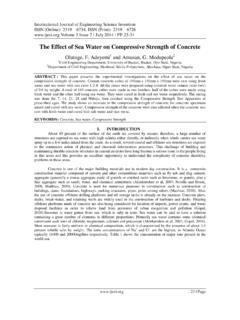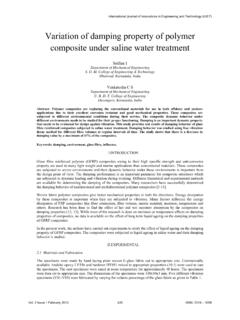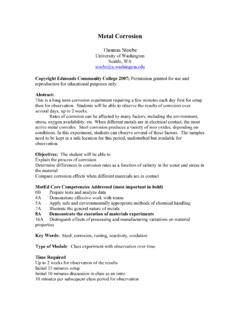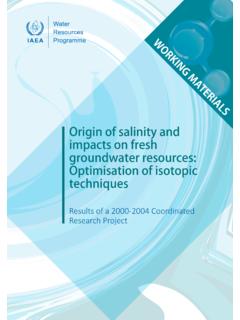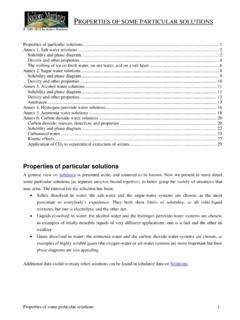Transcription of Irrigation Water Salinity and Crop Production
1 Irrigation Water Salinity and Crop ProductionSTEPHEN R. GRATTAN,Plant- Water Relations Specialist, University of California, Davis Irrigation Water quality can have a profound impact on crop Production . All irrigationwater contains dissolved mineral salts, but the concentration and composition of thedissolved salts vary depending on the source of the Irrigation Water . For example,snow melt or Water supplies from the Sierra Nevada contain very small amounts ofsalt whereas groundwater or wastewater typically has higher salt levels. Too muchsalt can reduce or even prohibit crop Production while too little salt can reducewater infiltration, which indirectly affects the crop. An understanding of the qualityof Water used for Irrigation and its potential negative impacts on crop growth isessential to avoid problems and to optimize Production . For more information onany of the issues found in this publication, please contact your local University ofCalifornia Cooperative Extension SALTSD issolved salts in Irrigation Water form ions.
2 The most common salts in irrigationwater are table salt (sodium chloride, NaCl), gypsum (calcium sulfate, CaSO4),Epsom salts (magnesium sulfate, MgSO4), and baking soda (sodium bicarbonate,NaHCO3). Salts dissolve in Water and form positive ions (cations) and negative ions(anions). The most common cations are calcium (Ca2+), magnesium (Mg2+), andsodium (Na+) while the most common anions are chloride (Cl-), sulfate (SO42-),and bicarbonate (HCO3-). The ratios of these ions, however, vary from one watersupply to another. Potassium (K+), carbonate (CO32-), and nitrate (NO3-) also existin Water supplies, but concentrations of these constituents are comparatively low. Inaddition, some Irrigation waters, particularly from groundwater sources, containboron at levels that may be detrimental to certain should be noted that substantial salinization potential is realized through nat-ural weathering and dissolution of soil parent materials, and these salt contributionswill attenuate or augment Irrigation Water ionic SALINITYT here are two common Water quality assessments that characterize the Salinity ofirrigation Water .
3 The Salinity of Irrigation Water is sometimes reported as the totalsalt concentration or total dissolved solids (TDS). The units of TDS are usuallyexpressed in milligrams of salt per liter (mg/L) of Water . This term is still used bycommercial analytical laboratories and represents the total number of milligrams ofsalt that would remain after 1liter of Water is evaporated to dryness. TDS is also oftenreported as parts per million (ppm) and is the same numerically as mg/L. The higherthe TDS, the higher the Salinity of the other measurement that is documented in Water quality reports from com-mercial labs is specific conductance, also called electrical conductivity (EC). EC is amuch more useful measurement than TDS because it can be made instantaneouslyand easily by irrigators or farm managers in the field. Salts that are dissolved in waterPUBLICATION 8066 FWQP REFERENCE SHEET OF CALIFORNIAA griculture and Natural partnership Farm Water Quality PlanningA Water Quality and Technical Assistance Program for California REFERENCE SHEET is part ofthe Farm Water QualityPlanning (FWQP) series,developed for a short coursethat provides training for grow-ers of irrigated crops who areinterested in implementingwater quality protection prac-tices.
4 The short course teachesthe basic concepts of Water -sheds, nonpoint source pollution(NPS), self-assessment tech-niques, and evaluation tech-niques. Management goals andpractices are presented for avariety of cropping Water Salinity and Crop Reproduction2 ANR Publication 8066conduct electricity, and, therefore, the salt content in the Water is directly related tothe EC. The EC can be reported based on the Irrigation Water source (ECw) or onthe saturated soil extract (ECe). Units of EC reported by labs are usually in mil-limhos per centimeter (mmhos/cm) or decisiemens per meter (dS/m). Onemmho/cm = 1 dS/m. EC is also reported in micrommhos per centimeter( mhos/cm). 1 mho = 1 conversions between ECw and TDS are made, but caution is advisedbecause conversion factors depend both on the Salinity level and composition of thewater. For example:TDS (mg/L) = 640 x ECw (dS/m) when ECw < 5 dS/mTDS (mg/L) = 800 x ECw (dS/m) when ECw > 5 dS/mSulfate salts do not conduct electricity in the same way as other types of , if Water contains large quantities of sulfate salts, the conversion factorsare invalid and must be adjusted Water Salinity , SOIL Salinity , ANDLEACHINGMany Irrigation Water supplies contain a substantial amount of salt.
5 For example, awater source with an EC of mmho/cm, a quality suitable for Irrigation of mostcrops, contains nearly 1 ton of salt in every acre-foot of Water applied. Irrigation cancontribute a substantial amount of salt to a field over the accumulate in the rootzone by two processes: the upward movement of ashallow saline - Water table and salts left in the soil due to insufficient leaching. Tocontrol Salinity from high saline Water tables, drains must be installed in the battle against salts that accumulate in the rootzone from the Irrigation Water , thesoil must be adequately is the process of applying more Water to the field than can be held bythe soil in the crop rootzone such that the excess Water drains below the root sys-tem, carrying salts with it. The more Water that is applied in excess of the crop waterrequirement, the less Salinity there is left in the rootzone despite the fact that moresalt has actually been added to the field.
6 The term leaching fraction(LF) is used torelate the fraction or percent of Water applied to the field that actually drains belowthe rootzone. For example, if 1 acre-foot of Water is applied to 1 acre of land, acre-foot drains below the rootzone, the leaching fraction is 1 10(10 percent).Below are some useful relationships between the Salinity in Irrigation Water (electrical conductivity of Irrigation Water , ECw) and the average rootzone Salinity (ECe). These relationships were developed by Ayers and Westcot (1985) and assumesteady state conditions. ECe is the electrical conductivity of the saturated soil paste(soil samples are saturated with distilled Water , the soil Water is then extracted, andthe EC is measured on the extracted Water ). These relationships predict what willhappen over the long term if the leaching fractions indicated are achieved andassuming that the ECe in the rootzone increases with depth (which would be evi-dence of leaching).
7 LF 10% leads to ECw x = ECeLF 15-20% leads to ECw x = ECeLF 30% leads to ECw = ECeIrrigation Water Salinity and Crop Reproduction3 ANR Publication 8066 ESTIMATING YIELD POTENTIALHow could you use these relationships to estimate the yield potential? Maas andGrattan (1999) provide an extensive list of Salinity coefficients for a number of hor-ticultural and agronomic crops. These coefficients consist of a thresholdand Salinity threshold (a) is the maximum average soil Salinity (ECe) the crop cantolerate in the rootzone without a decline in yield. The slope coefficient (b) is thepercent loss in relative yield the crop will experience for every unit increase in ECeabove the threshold. Using these coefficients, the yield potential (% Yield) can beestimated from the following expression: % Yield = 100 b (ECe a)Tables 1 and 2 provide Water quality guidelines for the most commonly growncrops in California. Table 1 assumes that the soil is well drained and that an LF of15 to 20 percent is achieved.
8 It is based on the formulas above and provides guide-lines for trees and vines. Table 2 provides the same type of guidelines for vegetableand row crops. These tables provide the Salinity level in the Irrigation Water (ECw)that, if used continuously to achieve an LF of 15 to 20 percent, would result in yieldpotentials of 100, 90, 75, and 50 percent. The ECw values at 100% yield representthe poorest quality Water that, if used continuously, will produce ECe levels equal tothe Salinity thresholds. For example, lettuce has the following Salinity coefficients:a = dS/mandb = 13 when expressed as ECeIf the average rootzone ECe throughout the season was dS/m, then the yieldpotential is 75 percent. If the average rootzone Salinity value of is then convert-ed to Irrigation Water Salinity assuming an LF of 15 to 20 percent, ECw is guidelines also assume that all other factors such as fertility, Irrigation schedul-ing, and pest control are managed to optimize crop is important to note that most of the experiments that were used to generatethese guidelines were conducted in the interior regions of California where the cli-mate is hot and dry during the summer.
9 Crops grown in the coastal regions wherethe climate is milder will likely tolerate greater salinities than indicated , much of the groundwater used for Irrigation in coastal areas ofCalifornia contains high levels of dissolved gypsum, which elevates the Salinity ofthe Water . However, crops irrigated with this Water do not suffer the same detri-mental effects as Cl-dominated waters with an equal fields where Salinity has increased in the rootzone to damaging levels, recla-mation leachingis recommended. A common rule of thumb is that the Salinity in thetop 1 foot of the rootzone can be reduced 80 to 90 percent by intermittently apply-ing 1 acre-foot of Water per acre of land. Irrigation Water Salinity and Crop Reproduction4 ANR Publication 8066 Table yield of tree and vine crops with long-term use of Irrigation Water with different levels of soil Salinity (potential yields are based on a 15 to 20 percent leaching fraction and do not account for the effects of specific elements)ECw (mmhos/cm)
10 Yield potential1 Tree and vine crops100%90%75%50% SAvocado3 SDate Palm TFig3 SOlive MTOrange SPeach SPear SPecan MSPersimmon SPistachio
